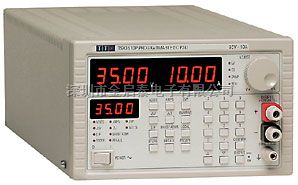OVERVIEW The Thurlby-Thandar TSX series represents the state of the art in high output PSU design.
A wide range of voltage-current output combinations will become available with power levels of 360 Watts and more.
Each output combination is available in two versions: with conventional analogue controls (TSX) and with programmable controls (TSX-P).
The P versions The TSX-P versions represent a major step forward in PSU design.
They combine a wealth of ?ease of use? orientated keyboard functions with full remote programmability. The result is the most comprehensive and versatile PSU control system available anywhere.
Linear post regulation for unrivalled performance
The heart of all TSX series PSUs is an innovative regulator design which combines switch mode pre-regulation with linear post-regulation.
The pre-regulator uses specially developed techniques to dramatically reduce the capacitance between input and output thus eliminating the high levels of common-mode noise normally associated with switch mode PSUs.
The linear post-regulator combines very low levels of output noise with excellent load regulation and transient response. The result is performance comparable with a pure linear design. Compact and lightweight The hybrid regulator design provides a PSU which is both smaller and lighter than competitive products.
The high thermal efficiency also means that the PSUs are silent in operation since fan cooling is unnecessary.
Constant voltage or constant current operation All TSX series PSUs can operate in both constant voltage and constant current modes with automatic crossover and automatic mode indication.
High accuracy metering All versions incorporate high resolution digital meters for both voltage and current.
V and I levels can be set to high accuracy prior to connection to the load and the limit settings can be checked at any time.
A damping switch for the current meter enables the average value of rapidly changing currents to be read.
Full overvoltage protection All versions incorporate a fully variable OVP trip to protect against regulator failure.
The output is fully protected and other protection functions include regulator overtemperature, and sense miswiring. | | Bench or rack mounting The attractively styled casing takes up very little bench space and incorporates a tilt bail to angle the front panel when required.
The case is half rack width (3U height), an optional rack-mount kit is available.
Output terminals are fitted at both front and rear.
* Note that in rack environments with limited ventilation fan cooling may become necessary.
A third display for clarity & safety To provide additional data and to avoid any possibility of ambiguity or error an auxiliary display is incorporated. All keyboard entries appear on this display for inspection before they are actioned by pressing the ?confirm? key.
This failsafe system avoids such possibilities as setting 25 Volts instead of 2.5 Volts as could occur on other less carefully designed systems. The auxiliary display is also used to set and display a variety of information.
Keyboard or quasi-analogue control Voltage and current levels can be entered directly from the keypad to a resolution of 10mV or 10mA giving unparalleled speed and precision.
Alternatively a rotary control can be used to set voltage or current in a manner simulating a conventional analogue control.
Watts display for added convenience When not being used for other purposes the auxiliary display shows the output power in Watts (Volts x Amps).
Delta-mode control Voltages and currents can be stepped up and down by a fixed increment set from the keyboard. This facility is invaluable for repetitive testing where, for example, the effect of 1% changes in voltage need to be observed. The delta increment is clearly shown on the auxiliary display.
Non-volatile storage of multiple settings 25 non-volatile memories are provided for storing frequently used settings. Each store holds a voltage, current and OVP setting.
This facility is particularly useful in repetitive testing situations within production, development or inspection areas.
Full bus control, GPIB & RS232 The P versions incorporate both GPIB (conforming to IEEE-488.1 & .2) and addressable RS232 (ARC) interfaces as standard.
The ARC system allows up to 32 instruments to be ?daisy-chained? together and to be individually addressed and controlled using a single RS232 port on a computer. Bus controlled functions include set voltage, set current, set OVP, set output on/off, read voltage, read current. |


